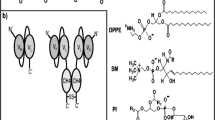Summary
Binding parameters were determined for four mouse monoclonal antibodies reacting with three antigens on the surface of fresh human ovarian carcinoma ascites cells, under nearly physiological conditions. The object of these experiments was to aid in the selection of the optimal monoclonal antibodies for intraperitoneal immunotherapy. The number of antigenic sites per cell, the effective equilibrium association constant (affinity) and the half-life for dissociation were: for Ab MH99, 1.2×106 sites/cell, (1.9−4.1)×108M−1, and 4 h; for Ab MX35, (3.2−4.1)×105 sites/cell, (3.4−4.8)×108M−1, and >10 h; and for Ab MW207, 1.3×105 sites/cell, (3.6−4.1)×109M−1, and 3.1 h, respectively. One of the antigens, MH99, is recognized by five different monoclonal antibodies, and competitive inhibition experiments demonstrated that two distinct determinants are present; this antigen is also recognized by the previously described Ab 17-1A. These binding data will aid the rational design of immunotherapy strategies.
Similar content being viewed by others
References
Baumal R, Law J, Buick RN, Kahn H, Yeger H, Sheldon K, Colgan T, Marks A (1986) Monoclonal antibodies to an epithelial ovarian adenocarcinoma: distinctive reactivity with xenografts of the original tumor and a cultured cell line. Cancer Res 46:3994
Benard J, Da Silva J, De Blois M-C, Boyer P, Duvillard P, Chiric E, Riou G (1985) Characterization of a human ovarian adenocarcinoma line IGROV1, in tissue culture and in nude mice. Cancer Res 45:4970
Ey PL, Prouse SJ, Jenkin CR (1978) Isolation of pure IgG1, IgG2a, and IgG2b immunoglobulins from mouse serum using protein A-Sepharose. Immunochemistry 15:429
Finbloom DS, Hoover DL, Wahl LM (1985) The characteristics of binding of human recombinant interferon-γ to its receptor on human monocytes and human monocyte-like cell lines. J Immunol 135:300
Fitzgerald DJ, Willingham MC, Pastan I (1986) Antitumor effects of an immunotoxin made with Pseudomonas exotoxin in a nude mouse model of human ovarian cancer. Proc Natl Acad Sci USA 83:6627
Giacomini P, Natali P, Ferrone S (1985) Analysis of the interaction between a human high molecular weight melanoma-associated antigen and the monoclonal antibodies to three distinct antigenic determinants. J Immunol 135:696
Hamilton TC, Young RC, Louie KG, Behrens B, McKay WM, Grotzinger KR, Ozols RF (1984) Characterization of a xenograft model of human ovarian carcinoma which produces ascites and intra-abdominal carcinomatosis in mice. Cancer Res 44:5286
Herlyn D, Powe J, Ross AH, Herlyn M, Koprowski H (1985) Inhibition of human tumor growth by IgG2a monoclonal antibodies correlates with antibody density on tumor cells. J Immunol 134:1300
Herlyn M, Steplewski Z, Herlyn D, Koprowski H (1986) Co 17-1A and related monoclonal antibodies: their production and characterization. Hybridoma 5, Suppl 1:S3
Johnston WW, Szpak CA, Lottlich SC, Thor A, Schlom J (1985) Use of a monoclonal antibody (B72.3) as an immunocytochemical adjunct to diagnosis of adenocarcinoma in human effusions. Cancer Res 45:1894
Kabawat SE, Bast RC Jr, Bhan AK, Welch WR, Knapp RC, Coving RB (1983) Tissue distribution of a coelomic-epithelium-related antigen recognized by the monoclonal antibody OC125. Int J Gynecol Pathol 2:275
Klotz IM (1982) Numbers of receptor sites from Scatchard graphs: facts and fantasies. Science 217:1247
Lehninger AL (1975) Biochemistry, 2nd edition; Worth Publishers, New York, p 186
Mason DW, Williams AF (1980) The kinetics of antibody binding to membrane antigens in solution and at the cells surface. Biochem J 187:1
Masuho Y, Zalutsky M, Knapp RC, Bast RC Jr (1985) Interaction of monoclonal antibodies with cell surface antigens of human ovarian carcinomas. Cancer Res 44:2813
Mattes MJ (1987) Biodistribution of antibodies after intraperitoneal or intravenous injection and effect of carbohydrate modifications. J Nat Cancer Inst 79:855
Mattes MJ, Cairncross JG, Old LJ, Lloyd KO (1983) Monoclonal antibodies to three widely distributed human cell surface antigens. Hybridoma 2:253
Mattes MJ, Look K, Furukawa K, Pierce VK, Old L, Lewis JL Jr, Lloyd KO (1987) Mouse monoclonal antibodies to human epithelial differentiation antigens expressed on the surface of ovarian carcinoma ascites cells. Cancer Res 47:6741
Pinckard RN (1978) Equilibrium dialysis and preparation of hapten conjugates. In: Weir DM (ed) Handbook of experimental immunology, 3rd edition. Blackwell Scientific, Oxford, p 16.1
Pirker R, Fitzgerald DJP, Hamilton TC, Ozols RF, Laird W, Frankel AE, Willingham MC, Paston I (1985) Characterization of immunotoxins active against ovarian cancer cell lines. J Clin Invest 76:1261
Primus FJ, Newell KD, Blue A, Goldenberg DM (1983) Immunological heterogeneity of carcinoembryonic antigen: antigenic determinants on carcinoembryonic antigen destinguished by monoclonal antibodies. Cancer Res 43:686
Scatchard G (1949) The attractions of proteins for small molecules and ions. Ann NY Acad Sci 51:660
Schlom J, Colcher D, Hand PH, Greiner J, Wunderlich D, Weeks M, Fisher PB, Noguchi P, Pestka S, Kufe D (1985) Monoclonal antibodies reactive with breast tumor-associated antigens. Adv Cancer Res 43:143
Segal DM, Hurwitz E (1977) Binding of affinity cross-linked oligomers of IgG to cells bearing Fc receptors. J Immunol 118:1338
Thampoe I, Ng ISC, Lloyd KO (1988) Biochemical analysis of a human epithelial surface antigen (ESA). Differential cell expression and processing. Arch Biochem Biophys (in press)
Tucco M, De Petris S (1981) Determination of equilibrium binding parameters of monoclonal antibodies specific for cell surface antigens. In: Lefkovits I, Pernis B (eds) Immunological methods, vol II. Academic Press, New York, p 1
Youle RJ, Uckun FM, Vallera DA, Colombatti M (1986) Immunotoxins show rapid entry of diptheria toxin but not ricin via the T3 antigen. J Immunol 136:93
Author information
Authors and Affiliations
Rights and permissions
About this article
Cite this article
Mattes, M.J., Lloyd, K.O. & Lewis, J.L. Binding parameters of monoclonal antibodies reacting with ovarian carcinoma ascites cells. Cancer Immunol Immunother 28, 199–207 (1989). https://doi.org/10.1007/BF00204989
Received:
Accepted:
Issue Date:
DOI: https://doi.org/10.1007/BF00204989




